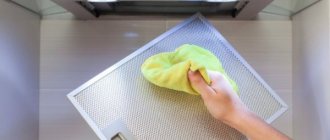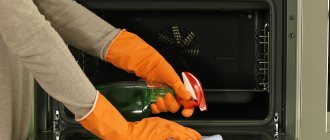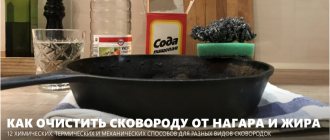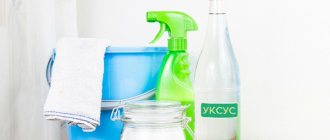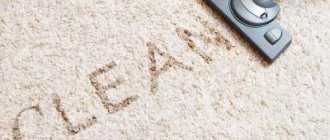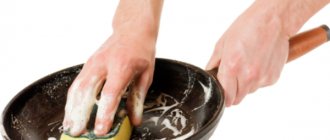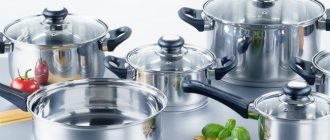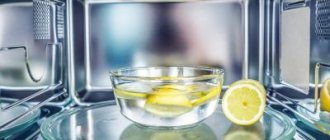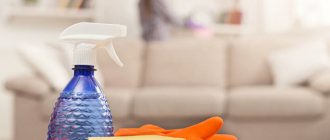Where food is prepared must be perfectly clean. This applies not only to dishes and stoves, but also to the hood in the kitchen. This useful device helps get rid of the unpleasant smell of tobacco smoke and burning in the kitchen and throughout the apartment, which often accompany the cooking process. With these advantages, the hood tends to quickly become dirty and covered with plaque and greasy stains, so it is better to regularly clean the hood grille, body and motor from carbon deposits, soot and grease.
This must be done because if there is a large amount of dirt, the grill becomes clogged, the functionality of the device is significantly reduced, and unpleasant odors spread throughout the apartment.
The hood must be washed regularly, since the filtered air carries soot, dust and droplets of fat that settle on the grille.
Why and how often should you wash?
The air in the kitchen constantly contains not only ordinary dust, but also particles of fat that rise from a boiling pot or squealing frying pan along with steam. Passing through the grate of the hood, the fat settles inside it and accumulates layer by layer.
You can deal with external dirt quickly - simply wipe it off without allowing it to dry out.
If you do not clean the internal parts (metal grease filter, fan) from grease and dirt, the equipment will simply stop performing its function.
Partial disassembly is done once every month or two to remove and clean the hood filter. General cleaning is carried out annually, and sometimes more often if there is extraneous noise or other operational disturbances.
There is an opinion that a powerful engine will cope better with exhaust air removal. Increasing the hood leads to the overturning of the draft. In apartment buildings, such phenomena as aromas from someone else's kitchen, tobacco smoke from a neighbor behind the wall indicate the presence of a supermotor in you or him.
No amount of washing will remove the smell from the hood if it circulates back from the air duct. To quickly solve the problem, simply open a window or vent to change the direction of air movement.
What not to do
If you do not want to harm your own health and your kitchen appliance, it is recommended to follow these rules:
- Replacement grease traps cannot be cleaned. Even if somehow it remains intact upon contact with water, the process of trapping fat will be significantly reduced.
- Parts made of plastic are prohibited from boiling.
- When cleaning the outer part of the hood, it is not recommended to use metal mesh or brushes, which may leave scratches.
- It is recommended to wash filters made of aluminum as rarely as possible using alkaline preparations, as this will negatively affect the metal and, over time, the process of destruction will begin.
- While working, it is necessary to open the windows to ventilate the room. This is due to the fact that toxic substances and odors will disappear and will not remain in the room.
It is best to clean your hood weekly with minimal effort than to experience the stress of not being able to remove the grease every year.
(Visited 347 times, 347 visits today)
Share
How to disassemble a hood: preparation stages
The basic design of any hood (Krona, Bosch, Hansa, Elicor) consists of a motor, a fan, a filter or two, and lighting. The entire system in the housing is assembled with a control infrastructure of varying degrees of complexity.
Before proceeding with disassembly, the equipment is de-energized!
How to remove the filter:
The instruction manual may contain disassembly instructions. First of all, read the recommendations.
- Make room for work.
- Most grease traps are removed by pressing the fasteners to the sides, after which the frame falls out or is pulled out of the grooves. Sometimes the grille is located behind a decorative strip secured with self-tapping screws.
How to open the hood to clean it completely:
- Remove the plug from the socket.
- Remove the wall mountings and unfasten the built-in hood from the cabinet shelf.
- Unscrew the screws in sequence on the common cover, the fan cover, and the fan mounting to the engine.
- Disconnect the motor and cables from the housing.
- Remove the ventilation pipe.
Household chemicals
Manufacturers of household chemicals have developed special anti-grease products for the kitchen. They contain powerful additives that break down even very strong and old fat deposits.
Spray Sanita
Sanita "1 minute" in spray form contains unique fat solvent additives . The spray gets rid of dirt and grease deposits on hoods, stoves, tiles, sinks and microwaves, fights germs and leaves behind a pleasant aroma.
The manufacturer guarantees ideal cleanliness within just one minute. Spray the product onto problem areas, after a minute remove the product along with grease and dirt.
If necessary, repeat the procedure and wipe the surface with a damp cloth.
Cinderella "Anti-Fat"
An affordable, effective product that gently cleanses stubborn stains. Suitable for use on different types of surfaces after test use on a small area.
Before use, the sprayer valve must be turned to the “open” position and the surface should be sprayed. After 20-25 minutes, remove dirt with a brush.
The main active ingredient of the Anti-Fat spray is soda. The natural cleaner does not act as quickly as chemical reagents, but the substance is safe
Synergetic for slabs
This eco-category product contains only natural ingredients and is not harmful to health . Easily copes with grease, soot, food stains and deposits on stone, ceramic, glass, glass-ceramic and stainless steel coatings.
Available in gel form - applied to contaminated areas and after a few minutes is completely washed off with clean water.
To enhance the action of Synergetic, you can use brushes or scrapers.
Reference! Eco-friendly product Synergetic is recommended for cleaning even in children's institutions.
"Shumanit" from "Bagi"
The spray grease remover instantly removes stubborn and stubborn grease from hoods, stoves, grates, steam traps, ventilation systems and dishes. Contains sodium hydroxide, solvents, surfactants and flavorings.
The spray is sprayed onto contaminated areas, allowed to act for a few minutes and washed off with a damp cloth several times. The manufacturer recommends working with gloves - the product irritates the skin .
Household chemicals Cillit bang
Two anti-grease products from the Cillit bang brand are suitable for cleaning hoods:
- Gel - fights fat deposits, rust, lime, and deeply ingrained dirt. Not suitable for processing porous, wooden, ceramic and glass-ceramic surfaces.
- Spray - easily copes with oil stains, dirt, soot, and burnt food residues. Not suitable for treating hot, damaged, halogen or wooden surfaces.
Cleaning with folk remedies
The improvised remedies, also called folk remedies, are not so harmless to the skin of your hands - so you should wear rubber gloves. Protect your eyes from caustic liquids with a pungent odor - vinegar, ammonia. Keep the window open while working. During the chemical reaction, the treated grating can be placed in a plastic bag.
For the grease-absorbing filter, select flat dishes in size so that it is completely immersed in the cleaning composition. For example, a baby plastic bathtub, a flat tray, or a baking sheet for baking in the oven will do.
Ammonia
Dissolve 2 tablespoons of ammonia in 4 liters of warm water and soak the hood parts for an hour. When the surfaces are clean, finish washing by rinsing in clean water.
Soda
You will need a suitable container, hot water and a pack of baking soda.
To clean a steel or aluminum hood filter with soda:
- heat 5 liters of water to a boil and pour in a glass of cleaning product, adding gradually with a spoon;
- place the mesh in boiling water and leave for 10 minutes;
- after soaking, the fat is washed off under running warm water, removing remaining deposits with a brush;
- The mesh is wiped and left until completely dry.
Vinegar
An effective remedy is obtained from a solution of concentrated acetic acid in water in a ratio of 1:7. The surface is treated with a sponge generously moistened with the composition. After 10 minutes, wash off with plenty of warm water.
Citric acid
You can use acid in powder, having previously dissolved it in water, or take a lemon, cut it in half and rub it on the contaminated areas. As it is absorbed, the juice will dissolve the fat. Heavily greasy areas are wiped with lemon juice several times until completely clean.
Laundry soap
The soap is grated and soaked in hot water. When the shavings dissolve, a mesh is placed there. The cooling water is heated, then it will be possible to wash off the fat faster. When the dirt gets wet, all that remains is to rinse, dry and put the mesh in place.
Combined means
To be sure, dirt removers are combined.
The dry method of cleaning with soda and vinegar is faster, without boiling:
- powder is evenly scattered onto a grid laid on a flat surface;
- For convenience, acetic acid 70% is poured into a spray bottle and carefully, without lifting it high, sprinkled over the layer of soda;
- leave to interact for 20–30 minutes;
- washed with plenty of water and dried.
Another good remedy that will allow you to wash a greasy hood with improvised means:
- add half a glass of liquid soap, 2 tbsp. to a large container with 5-6 liters of hot water. dry citric acid and half a glass of baking soda;
- soak the filter, preferably entirely;
- after 3–4 hours, the mesh is washed with a brush, removing any remaining dirt.
Mustard powder
The powder is mixed with water in such a proportion to obtain a semi-liquid slurry. The grate is placed on a tray, rubbed and covered with film to prevent the mixture from drying out. After 15–20 minutes, wash in water using a sponge or brush.
Whiteness
Whiteness copes with dirt, but is somewhat worse than soda. In addition, the smell fills the entire room even after washing with detergents. If you decide to soak the grate with white, wear safety glasses.
Saline solution
Table salt is dissolved in hot water. To obtain the required concentration, 200 g of salt per 5-6 liters will be enough. Softening of old fat occurs actively only at high temperatures, so the container is heated or boiling water is added.
Frame
The external part of the device is cared for much more often, as a result of which dust practically does not accumulate. If plaque appears, then your usual dishwashing detergent can easily handle it. Just lather it on a sponge/rag. An excellent solution is to apply foam to the surface of the case and leave it, wipe it off after a quarter of an hour.
If the body has not been looked after for a long time, it is recommended to cut the lemon and then wipe the entire body with half. After 5-10 minutes, remove the lemon juice with a damp cloth.
Advice! If necessary, the detergent can be replaced with window cleaning liquid.
How to clean with a steam generator
The steam generator will help clean the hood from grease without chemicals and without streaks. The equipment is equipped with convenient attachments that will allow you to penetrate into the most inaccessible corners. You can clean the inside of the hood without removing it from the wall.
With the help of steam, old fatty deposits are easily softened with a directed jet for 10–20 s, after which they are removed with a dry cloth. Garbage and dust are first removed with a vacuum cleaner so that they do not fly away under steam pressure throughout the kitchen.
Working with a steam generator requires certain skills. If handled carelessly, you can get burned by the steam.
Cleaning the grate by boiling
To clean the hood in the kitchen, if the above methods do not help, use a more effective method .
Pour water into a large saucepan (5 liters) and bring it to a boil, then add 2 large spoons of baking soda and half a piece of laundry soap, previously grated with a grater. For this procedure, you need to choose solid brown soap, since white and liquid analogues do not have the necessary properties. Place the filter in boiling water and boil it for 5 to 10 minutes. Then turn off the fire and, without removing the grate from the water, wait for the solution to cool. After this, the mesh is removed and the remaining fat is removed with a brush.
If the entire filter does not fit into the pan, it is processed in parts. You will need to boil one side first, then the other.
Washing with store-bought cleaning products
Specialized products such as “Shine Anti-grease”, “Shumanit” or “Azelite” do an excellent job of cleaning the filter. They completely eliminate stubborn fat and are packaged in containers with a dispenser. They are easy to use. The composition is applied to the grill and left for 10–15 minutes, after which it is thoroughly washed off.
Oven Cleaner is great for removing old grease from plastic parts.
Among the ingredients of cleaning products there are alkalis, so the effect of the composition is first tested on a small area.
If the hood has not been sanitized for many months, you can use radical fat solvents, for example, clean it with “Mole” or another product that removes fat and impurities that are difficult to dissolve in water:
- The grate is placed on a tray and the product is poured so that it covers it.
- A lot of foam will appear.
- Once the foaming stops, the dirt can be washed off.
The technical means contain alkalis or acids in a decent percentage, so they must be used according to their intended purpose. Such active reagents should not come into contact with kitchen work surfaces.
Preparatory activities
Before cleaning the hood, you must arm yourself with the factory instructions for the device and familiarize yourself with the manufacturer’s recommendations for care and operation. The paper should indicate how often to clean the hood and what cleaning products are suitable for cleaning.
Important! The products are selected depending on the material from which the body and parts are made - some chemicals can damage the coating.
Treatment is carried out only after the device is completely de-energized. Therefore, you will have to figure out how the hood turns off - otherwise, if liquid gets inside the housing, you risk getting a short circuit and electric shock.
Prepare the preparations and tools you will need for cleaning:
- personal protective equipment – gloves, respirator (if necessary);
- a spacious container for soaking removable parts;
- kitchen sponge - one or more;
- a cloth or cloth for wet cleaning;
- cleaning products depending on the chosen processing method.
My details
We have already figured out how to remove the hood grille and disassemble it completely yourself. Some nuances remain.
Grease filter
Filters are divided into disposable and reusable. In inexpensive models, volumetric liners made of acrylic or other synthetic material are simply changed every 2-3 months. Their pores quickly become clogged with oily impurities.
In recirculating hoods, an additional filter is installed that purifies the air with activated carbon. Can the carbon filter be washed? It is possible, like acrylic, but after that it will be useless.
Reusable grilles consist of a frame and a flat or three-dimensional mesh. They are made of metal. After washing and drying, they continue to serve and are effective until the hood becomes unusable. The main thing that allows dirt to settle on the mesh is the holes, so they must be clean.
Ventilation grill
The most basic way to clean grease from ventilation is with a steam generator. If equipment is not available, the ventilation grille is well soaked with soda and soap or washed with an anti-grease chemical.
Fan
It is quite difficult to wash the fan impeller by hand. It is soaked in alkali or acid.
Motor
The hood motor can only be cleaned using a dry method. After removing kitchen grease and dust from the surface with a napkin soaked in alcohol, its moving part is lubricated with grease or machine oil. If you do not clean the hood motor, its internal cavities and the rotor from plaque, it will overheat and may fail.
Frame
After disassembling, wash the body with soapy water. Despite the simplicity of the work, there is no need to rush. The edges of the metal are quite sharp, it is easy to get hurt.
Inner walls
To clean the inside of your home hood, you will need to apply some kind of product, for example, the one used to clean kitchen surfaces. Then the surface is washed with plenty of water.
Buttons
The buttons are washed so that they do not stick after pressing. Soda gruel, applied on all sides and rubbed with an old toothbrush, removes fatty deposits well.
Duct and pipes
Pipes usually do not require cleaning. The main deposits remain on the hood parts. If you want absolute cleanliness or the air duct is in a disrepair, everything that can be disassembled can be removed and washed with any anti-grease agent. In extreme cases, the pipes can be changed. Plastic, like corrugation, is inexpensive.
How to clean the hood from grease from the outside: rules for caring for the body
In addition to wiping it regularly (about once a week or at the same time as you wipe the dust in the house), you also need to consider some tips that will help keep your kitchen appliance working and looking attractive for much longer. Consider expert advice:
- Do not use aggressive chemical compounds on the kitchen hood hood. For example, if your appliance is made of enamel or stainless steel, it may oxidize, causing corrosion.
- You should not leave the hood wet after wiping, since when it is connected to electricity, a breakdown of current is possible, this is very unsafe.
- If some parts of the case (buttons, levers and switches) cannot be removed, they should be wiped with a soft cloth soaked in a detergent solution. Do not use knives, metal brushes or other sharp objects under any circumstances. This will result in damage to the housing structure.
- Be sure to wipe off dust from the outside of the hood and on the ductwork. This will protect the appliance from unnecessary accumulation of dirt (unhygienic for the kitchen) and prevent short circuits (which is so often caused by simple dust).
- If you are worried about the integrity and attractive appearance of your hood, read the instructions on how to treat it. Otherwise, use microfiber washed in laundry soap.
It is better to have the hood motor processed by a specialist, however, you can clean it yourself mechanically and finally wipe all parts with medical alcohol Dear readers of our resource, we are waiting for your feedback and comments on the topic of this article. We are always happy to receive feedback and are ready to discuss issues of interest.
Features of cleaning hoods made of different materials
It is much easier to clean a metal hood than a plastic or tempered glass one.
Stainless steel
You can remove grease from stainless steel quickly and easily using any available means. The material will withstand boiling and strong chemicals. The maximum that can happen is that the surface will darken.
It is not recommended to clean stainless steel with abrasive powders and metal brushes. The appearance of the metal will suffer, scratches will appear, from which dirt will be more difficult to remove during subsequent washing.
Made of aluminum
An aluminum hood can be washed with soda, laundry soap, table salt, and mustard. Acids actively oxidize the metal, causing dark spots to appear on the grate. Alkali dissolves aluminum and renders the mesh unusable.
In the dishwasher, the filter is washed separately from the dishes at temperatures up to 65 degrees. Dishwasher tablets are not used.
Made of plastic
Plastic can be soaked and washed in the dishwasher at low temperature, but cannot be boiled or scraped with metal objects. Plastic is resistant to chemical compounds. The steam generator is used only for heat-resistant plastics.
Glass
Glass parts require careful handling. It is better not to rub them with powders, but to use liquids, pastes and gels. Apply the detergent composition with a sponge or soft brush. Provided daily cleaning, you can get by with a glass cleaning spray.
Air duct
This item will be relevant only for flow-through hoods. You can tell that the air duct requires maintenance by the decreased draft. However, even if the draft is good, general cleaning is still required, at least once every couple of years.
Air ducts are different:
- Round and square, plastic.
- Round corrugated, made of aluminum.
The first option is prefabricated and can be easily disassembled. All that is required is to clean each element individually, then assemble and install in place.
Corrugated pipes are most often used, due to the low cost of the finished product. At the same time, fat accumulates much better and settles in all existing folds. It is recommended to change the pipe every few years, which will be much cheaper and more convenient than cleaning. If necessary, you can use a steam cleaner or “Mole” cleaning agent, after which you need to thoroughly rinse the pipe.
Proper care: life hacks for housewives
- Do not leave the hood running when it is not necessary. The air flow dries out the surfaces, and dirty sediment sticks tightly.
- Assemble the hood parts only when they are completely dry. The washing effect will last much longer.
- Do not turn on the stove burners idle, and especially when the fan is on. Plastic parts can be deformed by passing hot air.
- By cleaning the hood over the gas stove in a timely manner, you will not only avoid spontaneous combustion of accumulated deposits of fat and soot, but also increase the service life of the engine.
- Lemon not only cleanses greasy deposits, but also deodorizes the surface.
Cleaning the hood in an apartment or house really extends the life of household appliances. You just need to include it in the list of mandatory places for regular cleaning, along with the stove and kitchen apron. The equipment is designed in such a way that maintenance is simple. Each housewife will decide for herself what is the best way to wash off the fat.
Did you like the article? Tell your friends about it:
1 1
Security measures
Hood cleaners contain aggressive components that can damage the skin of your hands. To prevent burns and damage , rubber gloves should be used. You should also protect your eyes with glasses and wear long sleeves to prevent droplets from coming into contact with exposed skin. It is advisable to carry out work in a well-ventilated area, isolated from others. You should first restrict the access of children and animals to the room where the hood will be cleaned. Particular care should be taken with cleaning products for drains and drain pipes.
